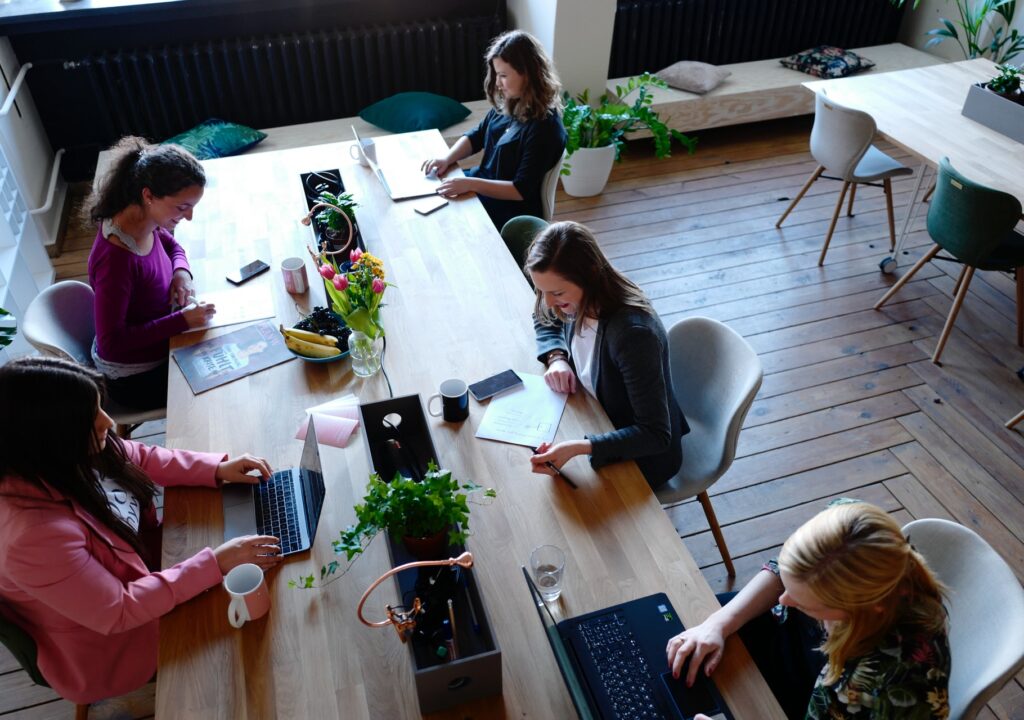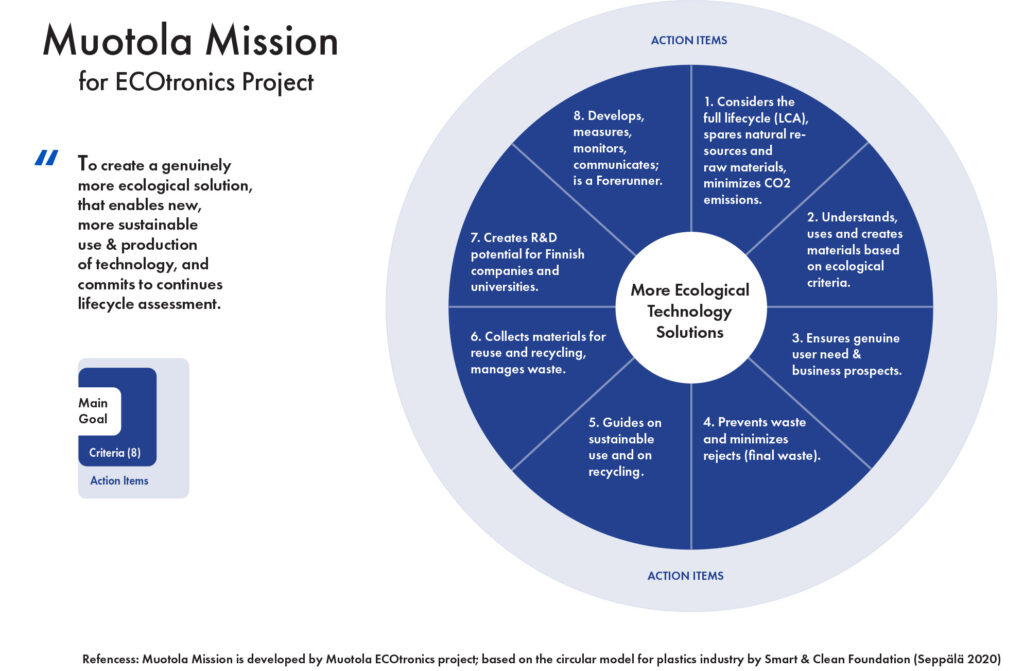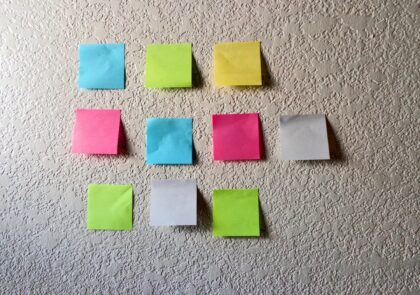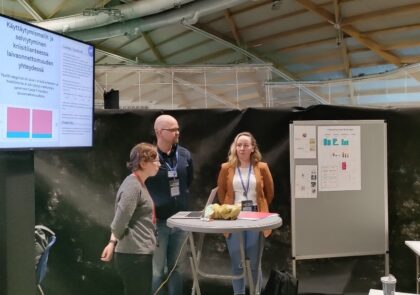
ECOtronics offered an opportunity for student trainees to develop their skills and to bring design thinking to the product development process. Developing sustainable electronics and optics is the one of the main goals of the ECOtronics project, and the principles of sustainability were shared within the team. Based on the product design created by the students, ECOtronics will publish and manufacture a product demonstrator later this year.
Authors: Johanna Välinoro & Sini Roine
About ECOtronics
LAB University of Applied Sciences is one of the partners in the ECOtronics project. The main objective of ECOtronics is to develop sustainable electronics and optics. (ECOtronics 2021) As the amount of electronic waste is vastly growing, there is a need for more sustainable solutions (Forti, Balde, Kuehr & Bel 2020, 9, 108). Ecotronics is a consortium of 12 organizations and businesses, whose mission is to support the Finnish electronics and optics industries, for example by promoting research & development and export opportunities. ECOtronics project is led by VTT, and the other research partners are LUT University and Tampere University. LAB Institute of Design and Fine Arts plays an important role in bringing in design, by (e.g.) creating user scenarios, visualizing information, and developing sustainable solutions, to the project.
Muotola Design Studio, established at LAB Institute of Design, is a living lab for design projects. Muotola enables students to work independently with project assignments while getting support from design professionals such as teachers and other experts. In fall 2020, ECOtronics project was the client for a Muotola team of five students. The team brought design thinking and design tools into the project, collaborated with the researchers, arranged brainstorming events, and discussed paths to more sustainable electronics.
Journey Starts
LAB design students joined the ECOtronics project when it was already in full action. Their assignment was to create a product design for a more sustainable electronics solution, a challenge with great potential and contradictions. Though technology is often promoted as a solution, many phases in especially the electronic products’ lifecycle, from sourcing to end of life, are harmful to environment and require re-design (World Economic Forum 2019). The project’s sustainability goal and use of new, innovative materials and lifecycle assessment (LCA) to capture the environmental impacts, targeted on clear improvements. The challenge was, how to build on opportunities while being mindful about not creating more waste and harm to environment. Could the new design do justice to the project’s sustainability goal?
Designer’s Role and Chance to Impact
The fresh team, with combined knowledge in industrial design and visual communications, shared the same design understanding. As today, design is seen more as a practice, an act of changing existing situations into preferred ones (Björklund 2019, 12), than an act of producing objects. Designer uses design thinking, an approach for human and user-centered innovation, creative problem solving, experimentation, and iteration across occupations (Björklund 2019, 13). Designer facilitates co-creation, a type of cooperation that engages customers to creative process, helping to arrive to the heart of the problems, and defining and creating the services that bring value to them. (Kirjavainen & Luukkonen 2019, 138). The definition of customer has also extended from businesses and users to cover the human and natural ecosystems. It is discussed, too, whether a true use of design thinking even leads to having planetary wellbeing as the key goal (Gaziulusoy 2020).

Picture 1: ECOtronics product design mission is developed by Muotola team; based on the circular model for plastics industry by Smart & Clean Foundation (Seppälä 2020). (Picture: Johanna Välinoro)
At times, it was challenging to apply design thinking to the technology-oriented R&D project. There was the pitfall of creating “yet another cool gadget, to demonstrate the new technological benefits. To avoid this risk, the team went back to ideation and finding the possible problems to solve. Talking to people – potential customers – about their needs, problems, and visions was valuable. Based on the interviews, combined with workshops, project expert interviews and other information gathered and evaluated, the team created user scenarios and visual storyboards. Visualizations even proved to be useful in communicating with the project team, and leading way to the final design.
Keeping the sustainability goal high-spirited was characteristic for the team’s work. This meant being both sensitive and brave in identifying and discussing any risks for satisfying, but later possibly compromising design decisions. It was even important to continue to question and discover, and not to arrive to a solution too soon. Expertise and support from VTT and LUT University project researchers and familiarizing with design frameworks, such as Cradle to Cradle (Cradletocradle.com 2021), were inspirational and helpful. The wish of giving the project a longer-term imprint on sustainable design led the team to create a mission for the ECOtronics product development. This mission can be used for sharing the project’s environmental goal, linked to practical actions. It may even help the project to establish an integral environment management system, as a recommended sustainability practice (ISO.org 2021).
Conclusion
Retrospect, the student team had an impact on the ECOtronics project. The team created a product design for a new solution, with shared customer and sustainability focus. By cooperating with project experts and creating the ECOtronics mission, they may even have nourished the project’s environmental goal. One of the biggest learnings was how much visual information helps in creating a common language with people across different fields. These visualization skills are even an asset for the work life after studies. Overall, ECOtronics provided the students with valuable experience in how to impact a project, as a designer, by design thinking and cooperation. ECOtronics will publish and manufacture the product demonstrator later this year. The ECOtronics project will continue till the end of January 2022.
References
Björklund, T. 2019. The changing role of design. In: Björklund, T. & Kelpi, T. (edit.). Design+. Organizational renewal and innovation through design. Helsinki: Aalto University.
CradletoCradle.com. 2021. [Cited 11 January 2021]. Available at: http://www.cradletocradle.com/
ECOtronics. 2021. ECOtronics sustainable electronics and optics. [Cited 9.2.2021]. Available at: https://www.ecotronics.fi/
European Commission, DG Environment. 2021. European Platform on Lifecycle Assessment (LCA). [Cited 11 January 2021]. Available at: https://ec.europa.eu/environment/ipp/lca.htm
Forti V., Baldé C.P., Kuehr R. & Bel G. 2020. The Global E-waste Monitor 2020: Quantities, flows and the circular economy potential. Bonn/Geneva/Rotterdam: United Nations University/United Nations Institute for Training and Research, International Telecommunication Union, and International Solid Waste Association. [Cited 14 January 2021]. Available at: https://globalewaste.org/publications/
Gaziulusoy, I. 2020. Business on Design and Sustainability, Jumping on Board or Jumping off the Cliff? Presentation at NODUS Talks on 28 November 2020. Webinar arranged by the Aalto University NODUS Sustainable Research Group 2020.
ISO.org. 2021. International Organization for Standardization (ISO). ISO 14000 Family – Environment Management. [Cited 11 January 2021]. Available at: https://www.iso.org/iso-14001-environmental-management.html
Kirjavainen, S. & Luukkonen, M. 2019. Increasing customer collaboration through co-creation. In: Björklund, T. & Kelpi, T. (eds.). 2Design+. Organizational renewal and innovation through design. Helsinki: Aalto University.
Seppälä, M. 2020. Innovaatioekosysteemeillä globaalien haasteiden kimppuun. Systems Change Finland Blog, 2.11.2020. [Cited 17.12.2020]. Available at: https://medium.com/systemschangefi/innovaatioekosysteemeill%C3%A4-globaalien-haasteiden-kimppuun-81f1d6dfa4e8
World Economic Forum. 2019. New Circular Vision for Electronics. Time for a Global Reboot. [Cited 11 January 2021]. Available at: http://www3.weforum.org/docs/WEF_A_New_Circular_Vision_for_Electronics.pdf
Authors
Sini Roine works as a Project Assistant in ECOtronics project at LAB University of Applies Sciences, Institute of Design and Fine Arts.
Johanna Välinoro is a Design Student in the Visual Communications, Graphic Design, at LAB University of Applied Sciences, Institute of Design and Fine Arts. She worked as a Trainee in ECOtronics project in fall 2020.
Illustration: https://unsplash.com/photos/ZKHksse8tUU (CC0)
Published 9.2.2020
Reference for this article
Roine, S. & Välinoro, J. 2021. Designer’s role in developing more sustainable technology – Experiences from ECOtronics project. LAB Pro. [Cited and date of citation]. Available at: https://www.labopen.fi/lab-pro/designers-role-in-developing-more-sustainable-technology-experiences-from-ecotronics-project/






